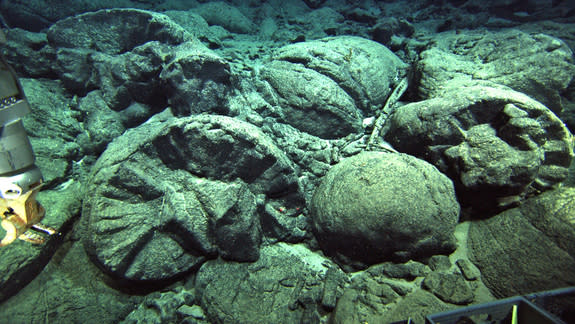 Science and Weather
Science and WeatherUndersea volcanoes may hold important clues in searching for different alien lifeforms

An ambitious research expedition has set sail from Hawaii this week to explore the mysteries surrounding a massive undersea volcano that is giving birth to the State's newest island.
Referred to as the youngest volcano in the Hawaiian island chain, Loihi's summit lies a little more than 3,000 feet below the waves, but may not breach the surface for another 10,000 to 100,000 years from now.
An international team of scientists is now hoping to send an autonomous submersible 16,000 feet to the yet-unexplored base of Loihi seamount – a volcanic mountain that rises nearly 10,000 feet above the Pacific Ocean floor.
While vacationers won't be able to see any sign of the new island for many millennia, there's a lot of action going on below the waters. It was only back in July 1996 that Loihi set a new record for the largest cluster of earthquakes ever associated with a Hawaiian volcano with some 4,000 tremors in a two week period.
Coincidently, at the same time on the island of Hawaii, the world's largest active volcano Mauna Loa, may be rumbling back to life this week too.

Past research trips to Loihi have examined these types of eruptions, but the one they have embarked on now will focus on mapping the volcanic landscape, collecting water samples and investigating tiny microbes that currently thrive in this inhospitable marine environment .
Iron-oxidizng bacteria live within hydrothermal vent fields that blanket the flanks and base of the volcano. These tiny creatures feed off the iron plumes that are continuously belched by the volcano through these vent holes. This unusual energy source then helps the microbes create copious amounts of orange-coloured rust as a by-product.
“Loihi is a giant leaky iron mountain, providing plenty of energy for iron-eating bacteria near the vents, and pumping iron out into the ocean as the hydrothermal fluids disperse,” said expedition team leader Brian Glazer, a researcher at University of Hawaii at Mānoa in a press statement.
Related:
Studies of extreme Earth life can aid search for alien life forms, scientists say
In search for life on alien planets, checklist needed
Antarctica's extreme salt-loving microbes swap DNA
Despite the eternal darkness, intense pressures and scorching hot, toxic plumes, life has managed to find a way to eke out a living around one of the most extreme places on Earth.
Scientists call these kind of extreme-loving lifeforms – extremophiles – and they have been found around the world living in boiling water, in nuclear reactors and even under a half-mile of ice in Antarctica.
Glazer and his team hope that by studying the chemical fingerprints of the geological features produced by Loihi's bizarre iron-eaters, that it will directly help guide us in where to hunt for life on other worlds.
These strange lifeforms on Earth may offer clues to what life may look like on planets and moons in the solar system. Some scientists believe that simple-life forms may exist buried underground on Mars, and within the ice-covered moons of Jupiter and Saturn.
"In accessing Loihi, we have a window to the ancient Earth that also provides clues about the potential for life ‘out there’ in habitats that could exist on places like Mars or Europa,” Glazer said.
(Photo via LiveScience. Chart via EarthRef.org Digital Archive)


